By Rob Coppinger in London
It encapsulates all the boyhood dreams I aspired to; it’s my chance to go through the sound barrier, experience the g forces. I watched NASA’s attempts and was inspired,” says Virgin Galactic customer and University of Cranfield visiting professor of engineering and applied sciences Adrian Reynard.
Reynard hopes to fly on a suborbital trip in the near future on Virgin Galactic’s SpaceShipTwo (SS2) vehicle. And the 1960s race to the Moon was an inspiration not only for him, but for big business wanting to make profits from the impending space-age revolution.
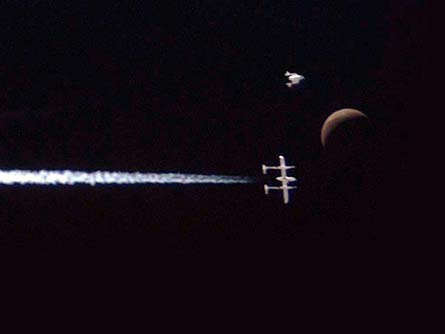 |
|---|
| The success of SpaceShipOne and White Knight has spurred the space tourism industry |
In 1967, at the American Astronautical Society’s Hotels in Space conference, then president of Hilton Hotels William Barron Hilton spoke of his company’s plans: “Scarcely a day goes by when someone doesn’t ask me, jovially, when the Lunar Hilton is going to be opened. They’re joking, of course. But I don’t see it as a joke at all.”
The laughing began to stop 30 years later when in December 1990 Japanese television news director Toyohiro Akiyama flew to the Russian Mir space station for an eight-day mission. He was not designated as the world’s first space tourist, but it was a start, and that distinction would soon go to New Yorker Dennis Tito.
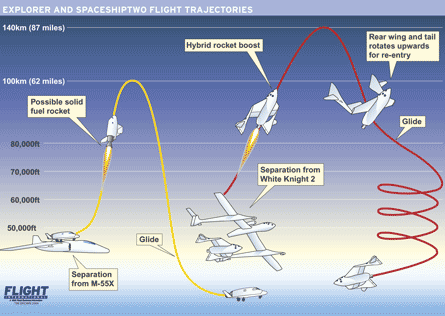 |
|---|
Tito made his millions with his investment management consulting firm Wilshire Associates. He arranged to travel to Mir after Akiyama, but Russia decided to de-orbit the ageing outpost before he could fly. Then in April 2001 Tito became the world’s first space tourist when he flew to the International Space Station (ISS).
The company that sent him, Space Adventures, has since despatched South African Mark Shuttleworth and US citizen Gary Olsen to the ISS, and Japanese entrepreneur Daisuke Enomoto is in training to fly in September. There are more tourists preparing to fly in the near future and it would appear that until the ISS is de-orbited, which is expected in 2016, Russia and Space Adventures will be happy to provide trips to the station.
While the ISS is not purpose-built for tourists, US hotelier Robert Bigelow announced in 2000 that by 2015 his first commercial space complex could be in orbit, costing around $500 million. Having invested $75 million so far, his company Bigelow Aerospace expects a subscale inflatable technology demonstrator to be launched later this month by a Russian Dnepr rocket, and it aims to fly a full-scale habitable structure in 2012. That inflatable technology would be the basis for the habitable space complex, which Bigelow declines to call a hotel.
If Bigelow manages to launch his complex in 2012, it is unlikely there will be any passenger-carrying vehicles able to reach it. Certainly there are no proposed or operational spacecraft designated to take people to it. So the hotelier has announced the $50 million America’s Space Prize, which requires a US-built, largely reusable five-person spacecraft capable of reaching at least 400km (250 miles), achieving enough speed for two full orbits of the Earth, able to dock with a Bigelow expandable space habitat, capable of staying docked for six months, and able to complete two orbital missions by 10 January 2010.
Unfortunately no teams have come forward to attempt to win the prize.
While Space Adventures has a monopoly on sending people to an orbital destination, in February it became one of several companies offering suborbital flights. The other near-term contenders for this nascent market are the UK’s Virgin Galactic, Oklahoma-based Rocketplane, Sprague Astronautics and Seattle’s Blue Origin.
Owned by Amazon.com founder Jeff Bezos, Blue Origin aims to test-fly prototype single-stage suborbital vehicles from a Texas launch site from the fourth quarter of this year, and to begin commercial services in 2010.
Sprague Astronautics’ is developing its single-stage Altairis vehicle, powered by the company’s 40,000lb-thrust (178kN) RLE-40 liquid-oxygen/kerosene rocket. Despite having conducted no test flights so far, owner Jeff Sprague hopes to provide commercial flights from Florida Space Authority’s Cape Canaveral site in the first quarter of 2007. The Altairis would launch vertically, carrying six passengers and a mission commander and land horizontally using a parafoil and airbags.
With tickets costing up to $250,000, over 200 people worldwide are known to have signed up for flights with Virgin Galactic and Space Adventures. However, market studies have suggested that there could be as many as 1,000 customers for the first year of commercial suborbital spaceflights. So far ISS trips have averaged only one tourist every 16 months.
By 2021 suborbital space tourism could grow into a $700 million a year industry, launching 14,000 tourists annually, forecasts US consulting firm Futron in its latest space tourism market study, published this month.
“The customer is normally 55 years old and, for suborbital flight, 72% of them are male,” Futron space and telecommunications programme manager Janice Starzyk told the Royal Aeronautical Society’s space tourism conference in London on 7 June. Her forecast follows Futron’s 2002 survey, which also concluded the market would be worth $700 million a year by 2021.
Based on a ticket cost of $200,000, Starzyk concluded there could be a market of around 1,000 customers for suborbital services starting in 2008. With two years to go, the realistic contenders for those 1,000 customers are Virgin Galactic, Rocketplane and Space Adventures.
Scaled up
Virgin Galactic’s SS2 is based on the Scaled Composites-designed SpaceShipOne (SS1), which in 2004 flew the first private manned spaceflights and won the $10 million X Prize for SS1’s developer, Paul Allen’s Mojave Aerospace Ventures.
 |
|---|
SS2 and its White Knight 2 (WK2) carrier aircraft are expected to be test flown from Mojave Spaceport in the fourth quarter of 2007; both vehicles are under construction. Three times the size of SS1, with a fuselage diameter as large as a Gulfstream V, SS2 will carry six passengers and have two pilots.
SS2 and WK2 will use a common fuselage, as did SS1 and its White Knight carrier aircraft. This will enable training for SS2 passengers and crew to be conducted in WK2. What else is known of WK2 is that it is based on technology from the long-distance record-breaking Virgin Atlantic Globalflyer and plans for future, possibly orbital, spaceships has led Virgin Galactic to increase its wingspan to up to 39m (128ft). White Knight’s wingspan is 25m.
SS2 will have a redesigned hybrid rocket motor, probably with a new solid fuel, and wing spoilers, will use the SS1’s feathered wing technique for re-entry, and is likely to retain the nose skid for a landing brake. WK2 will air-launch SS2 1h into the flight and at an altitude of at least 50,000ft.
Experiencing over 4g as it ascends, the rocket-powered glider will reach a apogee of 140km. Passengers will lie on beds with their feet raised to cope with re-entry forces that will peak at 7g, but could have the opportunity to float around during the 5min of weightlessness beforehand.
SS2’s increased glide range could enable it to land at Roswell instead of the New Mexico Southwest Regional Spaceport near Upham, from where it might be launched from 2009.
Virgin Galactic president Will Whitehorn told the Royal Aeronautical Society’s space tourism conference that system testing was “going swimmingly”. Operations director Alex Tai and test pilot David Mackay have been flying the SS2 cockpit simulator at Scaled Composites in California to provide feedback on the pilot interface.
Tai wants to hire military pilots with airline experience and expects six to be involved in each flight. “We’ll have two pilots in White Knight 2, two pilots on SS2, a pilot in mission control, and probably a chase aircraft,” says Tai, who will fly the first commercial flight. Starting at one flight a week by 2009, Virgin Galactic could eventually have 30 pilots flying 10 SS2s.
The company has approached the US Federal Aviation Administration and an employment consultant to discuss hiring personnel, says Tai, who adds that Virgin Galactic has received applications from NASA pilots. Personnel from the US space agency and US Department of Defense could be used as pilots if specialist payloads are flown.
Virgin Galactic has ordered five SS2s, with an option for seven more, from Scaled Composites/Virgin Group joint-venture The Spaceship Company. It will build the vehicles at a former British Aerospace hangar next to Scaled Composites at Mojave airport.
While SS2 is a unique vehicle, Rocketplane plans to use a 12.8m-long converted Bombardier Learjet 25, which it calls the Rocketplane XP. Turned into a four-seater it is to be put through a 25-flight atmospheric test programme from January, followed by a maiden launch in July 2007.
The Learjet’s modifications include its wing, which is reset at an incidence angle of 2.25°, fitted with split elevons for pitch and roll control, and has a dihedral outboard section. Taking off and landing on a conventional runway, the Rocketplane XP has a maximum take-off weight of 8,720kg (19,200lb) and a thrust requirement of 36,000lb.
Ascending to 25,000ft using the Learjet’s General Electric CJ610 turbojets, the pilot will execute a 3g pull-up for a 70° climb after igniting its Rocketdyne RS-88 rocket, which will burn for 70s until 150,000ft, after which the XP will coast to a 330,000ft apogee. There, tourists will experience 3.5min of weightlessness, while the vehicle’s reaction control system re-orientates it for a 40-45° re-entry before it starts S-turns to slow down and land at Oklahoma Spaceport, from where it will operate.
Oklahoma Space Authority expected to receive its spaceport licence from the FAA last month. Meanwhile, the FAA says that Southwest Regional Spaceport has environmental work to complete to obtain its licence, and that Mojave Spaceport will have to renew its operating licence, specifically granted for the 2004 SS1 flights, even though SS2 is similar in configuration.
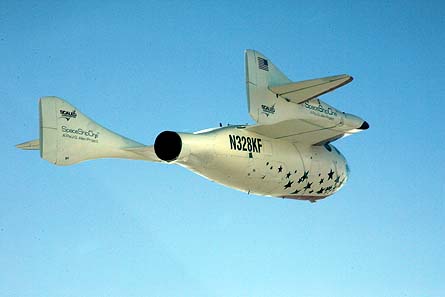 |
|---|
| SpaceShipOne |
Space Adventures’ five-person Explorer suborbital vehicle is based on the Myasishchev Design Bureau’s C-21 rocket glider and is being developed in conjunction with US investment partner Prodea and Russia’s Federal Space Agency. Explorer will be air launched from 50,000ft, like SS2, from a carrier aircraft, the Myasishchev M-55X.
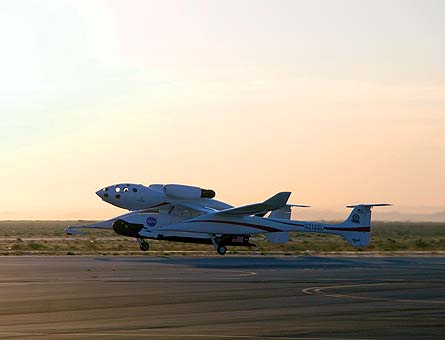 |
|---|
| White Knight |
The C-21 design used a solid rocket, which was jettisoned in flight, but Space Adventures will not confirm Explorer’s rocket type. It has said that Explorer will be flight tested over 100 times and is to operate initially from Russia’s Zhukovsky air base. Zhukovsky, near Moscow, is likely to be the development centre for Explorer because it has a 5.4km-long runway and a government-controlled flight test zone of 40,000km2 (15,000 miles2).
As Russia’s Federal Space Agency is overseeing the development, Space Adventures will have to comply with Russian technology export controls. But the company describes the rules as not as “wide sweeping” as US regulations.
US restrictions
As a non-US company, the UK’s Virgin Galactic has to obtain technical assistance agreements under US technology transfer rules to work with Scaled Composites for SS2 and these cost hundreds of thousands of dollars and take months to obtain. Even then there are restrictions on what Scaled can show the Virgin company for the time being.
The Space Adventures announcement of its suborbital service on 16 February this year was accompanied by declarations from the Singapore and United Arab Emirates governments pledging financial support for spaceports worth $115 million and $265 million, respectively, as well as regulatory approval for operations.
Like Space Adventures, Virgin Galactic will initially fly from its development centre, at Mojave, and then move to a purpose-built spaceport, which is expected to be New Mexico’s $225 million Southwest Regional Spaceport. Last month the New Mexico state government selected its spaceport architect. This follows the passage in February of bills through the state’s House of Representatives and Senate enabling cities and counties to increase local sales taxes, with voter approval, to help finance the spaceport. The state is also lobbying for federal funds.
Space Adventures has also had informal talks with the New Mexico government about operating from the spaceport. Based near Upham, 4,700ft above sea level, the centre will have a 90m-wide, 3,660m-long runway to accommodate vehicles larger than SS2. Virgin Galactic’s Whitehorn has spoken of an orbital vehicle, SpaceShipThree (SS3), to be developed if SS2 is commercially successful.
But despite all this progress, the brave new curved horizon of space tourism could be troubled by the legacy of the US-Soviet Moon race and the superpowers’ fears about the exploitation of space. Four treaties were signed during the Cold War: the 1967 Outer Space Treaty; the 1968 Agreement on Rescue and Return; the 1972 Liability Convention; and the 1976 Registration Convention.
For space tourism the legal implications of these agreements are that states bear responsibility for the actions of their nationals; states are liable for third-party damage caused by their citizens’ activities; and litigation is through the nations’ diplomatic channels, not via individuals.
As Space Adventures is a US firm and Virgin Galactic a UK company, these two nations will have to prepare themselves for liability litigation, which they are treaty-bound to conduct through diplomatic channels.
Virgin Galactic has already spoken to the UK’s British National Space Centre (BNSC), which is involved in the UK’s launch licensing process, about its plans. BNSC is to conduct a consultation with human spaceflight stakeholders in the coming months and wants to involve the UK’s Civil Aviation Authority, which has previously been responsible for giving permission for UK rocket launches due to issues of notification for pilots and airlines.
Space Adventures is yet to have discussions with the FAA. If there were moves at the United Nations to bring about changes to these treaties, or new treaties, the UN committee charged with dealing with such matters is its Committee on the Peaceful Uses of Outer Space.
Niklas Hedman, the UN Office for Outer Space Affairs’ committee services and research section chief, is clear that until now space tourism has not been a priority. “The issue of space tourism has not been a topic for discussion in the committee and its two subcommittees. It happens from time to time that delegations in statements mention space tourism,” he says.
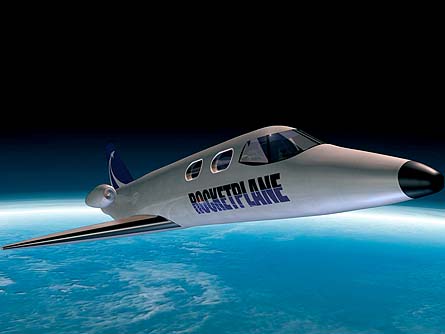 |
|---|
| The Rocketplane XP will be on a converted Learjet 25 |
And neither do space law watchers expect the UN to get involved soon. “This will get a long way down the track before they get involved,” says Darcy Beamer-Downie, air and space lawyer for aerospace legal services company Clyde and Co, Beaumont and Son Aviation. “There are probably more issues over orbital flights, as there is no sovereignty. For now I don’t think there is going to be enough [space tourists to make it geo-politically significant]”.
Defining space
Another as-yet unresolved issue Beamer-Downie points to is the legal delineation between air and space. Only Australia has made the legal distinction and has chosen 100km as the end of the atmosphere.
The final rules by which suborbital tourism operators in the USA will have to abide is another unfinished legal issue. The FAA’s commercial space transportation office published the notice of proposed rulemaking on experimental permits for reusable suborbital vehicles at the end of March and interested parties had 60 days to respond.
With that consultation period over, the US agency is drawing up the final rules, in discussion with the industry. It expects to have these ready for formal publication by the end of September. The rules are expected to allow passengers to sign waivers protecting the suborbital vehicle operator from litigation for injury or death.
However, waivers have no basis in UK law and are not thought to be completely litigation-proof under US legislation. Relatives of the injured or dead passenger may still decide to sue a company, even if that individual had obtained insurance against disaster.
Potentially expensive to the point of making space tourism uneconomic could be a need for three different insurance policies: one for the passenger, one for the vehicle – known as hull insurance – and one for third-party damage, which is required by international treaty. Those who operate in the aerospace insurance market expect the industry to draw its conclusions from the operating history of a range of specialist vehicles.
Timothy Wright, group space underwriter for insurer Global Aerospace, expects unmanned launches, previously insured Shuttle missions and the flights of SS1 to inform the market’s decisions on premiums.
“The aviation industry needs to see a number of positive flights. An ongoing demonstration of safety will help. Concorde was an aviation risk, but was accepted as it demonstrated safe flight over time. But there is the double whammy [for space tourism] that this is a new type of vehicle in a new environment, space.”
But what will the insurers make of Space Adventures’ recently proposed $200 million circumlunar trip? How will it determine premiums for a five-day journey using a new version of the Soyuz capsule? Launched to the International Space Station, the two tourists who would have paid $100 million each and their Soyuz pilot would wait for the translunar injection (TLI) stage.
A modernised version of Russia’s Block DM upper stage, it would reach orbit, while the Soyuz, having left the ISS, would dock with it. The TLI would then push the capsule and its service module on a trajectory to orbit the Moon at an altitude of 100km. But there is no descending to its surface. Despite Hilton’s 1960s plans, there will be no hotel waiting for them for some time, but no one is laughing at the prospect any more.
Source: Flight International
















